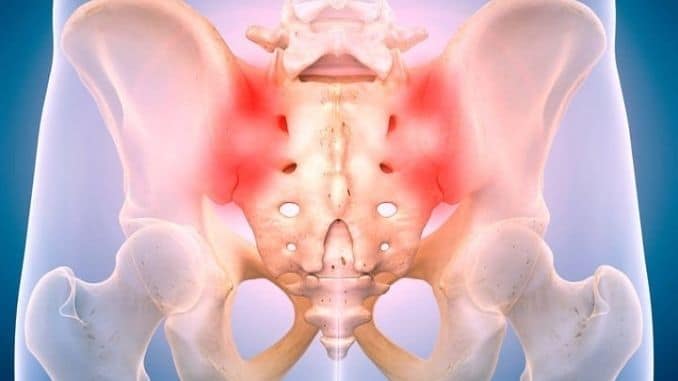
If you have low back pain, it might be your sacroiliac (SI) joint acting up. Unfortunately, this problem is frequently overlooked even by experienced doctors. If you have pain localized in the lower back, there’s a 15 to 30 percent chance it’s one, or both, of your SI joints. Inflammation or pain in this area is also called healing the sacroiliac joint, or sacroiliitis. Let’s look at the characteristics of SI joint anatomy, injury, symptoms, and treatment.
What Is the Sacroiliac Joint?
Any place where two bones meet is a joint, but the SI joint is not a hinge joint like your elbow. Moreover, the SI joint is where the sacrum and ilium join together, which means you have two SI joints. The sacrum is near the lowest part of your spine, and the ilium is part of your hip bones. The SI joints are the junctions where your spine inserts into your pelvis. The SI joints do a lot of work by supporting and distributing your upper body weight over your pelvis and legs.
Furthermore, each SI joint stays in place thanks to the jagged edges of the bones fitting together like puzzle pieces. Plus, strong muscles, tendons, and ligaments pull the bones together. Even though the SI joint doesn’t have much movement, there’s just enough mobility to help you stay balanced and steady on your feet. This movement is also important for women to be able to give birth. Between the bones, cartilage and fluid help keep things moving smoothly. The SI joint also has many surrounding nerve endings, which can transmit pain signals.
What Are the Causes of SI Joint Pain or Injury?
Like any other joint, the SI joint can be affected by a variety of factors leading to pain. The most common causes of SI joint discomfort are:
- Osteoarthritis: Wear and tear over time can lead to SI joint breakdown; the cartilage and bones breakdown or get deformed leading to abnormal movement and pain
- Ankylosing spondylitis: This is inflammatory arthritis that primarily affects the SI joint; it can cause bone fusion, pain, and limited movement; this disorder can also affect other bones in your body, the heart, and eyes
- Gout: Caused by uric acid crystals that get deposited in joints
- Trauma: Any kind of injury to the SI joints can lead to acute or chronic pain
- Pregnancy: Women generate the hormone relaxin during pregnancy, which loosens the SI joint; the weight of the growing baby can cause SI joint pain; multiple pregnancies increase the risk of SI joint problems
- Leg length: Difference in leg length may cause abnormal stress to the SI joints leading to pain and/or inflammation
- Overuse: Prolonged standing; standing on uneven surfaces; bearing more weight on one leg; and excessive climbing, running and jumping call all cause SI joint pain
What Are the Symptoms of SI Joint Dysfunction?
Moreover, the main symptom of sacroiliitis is pain which can be throbbing, sharp, tight, achy or burning. Typically the pain occurs in one or more of the following areas:
- Lower back
- Buttocks, hips or pelvis
- Groin
Pain may increase with movement, such as going from a sitting to standing position. You might also feel leg weakness or a sensation of instability as if your legs might buckle.
How Is SI Joint Dysfunction Diagnosed?
The first step is to be examined by an experienced physician. SI joint problems are often confused with other bone disorders like lumbar spine arthritis or lumbar disc disease. For this reason, look for a doctor that has experience in treating low back problems and sacroiliitis.
Taking a thorough history of your symptoms can help in making the diagnosis. For instance, if your work requires you to stand for long hours on uneven surfaces, it increases the chances that sacroiliitis is causing your symptoms.
Moreover, your doctor will examine you, and other tests might be required to make the diagnosis. Additional tests can include X-rays, MRI or CT scan. Another technique sometimes used is a diagnostic injection into the SI joint. If injecting a numbing medication (lidocaine) into the SI joint relieves your symptoms, there’s a good chance you have sacroiliitis.
How Is SI Joint Dysfunction Treated?
If you and your doctor take a good look at your lifestyle, work and exercise habits, you’ll probably discover an activity that makes your symptoms worse. This means you’ll have to modify your activity or stop it completely, at least until healing the sacroiliac joint occurs.
Moreover, other treatment modalities can include physical therapy and massage therapy. One of the goals of physical therapy is to help strengthen the muscles around the SI joint to provide more stability.
Furthermore, in some cases, cold packs to your lower back just above the buttock area may help reduce the inflammation. Never apply cold directly to the skin. A bag of ice or frozen gel packs wrapped in a damp cloth works best. Try applying cold for 15 to 20 minutes every 8 to 12 hours.
Manual Manipulation for Sacroiliitis
In some cases, adjustments to bone alignment by a chiropractic doctor may help relieve pain. Adjustments may also help improve the range of movement. Choosing a practitioner with experience in manual manipulation of the SI joint is critical. Ask for personal recommendations when seeking this kind of treatment.
Medications for Healing the Sacroiliac Joint Pain
When conservative measures fail, your doctor might recommend medications for the treatment of SI joint dysfunction. Moreover, the most common drugs used to treat sacroiliitis are the nonsteroidal anti-inflammatory class (NSAIDs). These include medications like ibuprofen and naproxen. Muscle relaxants like cyclobenzaprine might also be used. Moreover, in more severe cases, corticosteroid pills or injections may be required.
Radiofrequency Ablation for Healing the Sacroiliac Joint
This treatment is aimed at using heat to neutralize the nerve endings in the SI joint. It is a sort of nerve block procedure. Radiofrequency ablation for healing the sacroiliac joint works like this:
- You are given a relaxant to calm you.
- A local anesthetic injection is applied.
- Using a hollow needle, the doctor locates the area to be treated.
- A microelectrode is passed through the needle.
- Radiofrequency current is passed through the electrode to heat and numb the nerve ending.
Radiofrequency ablation typically provides relief for weeks to months. It should not be considered a long-term cure for sacroiliitis.
Water Therapy for Healing the Sacroiliac Joint Problems
Ankylosing spondylitis (AS) is one of the most serious forms of SI joint disorders. In many cases, the best treatment for AS is water therapy. This may work even better than the best medications. Even if you aren’t a good swimmer, you can still benefit from this activity, for example, with water aerobics.
A qualified instructor can guide you with exercises designed to strengthen the muscles that support your SI joint. Other muscle groups like abdominals, thighs, low back, glutes and hips not directly connected to the joint can also be targeted. When neighboring muscles are strong, the SI joint has less work to do. Also, since you float in the water, your movements are smoother, which may lead to improved healing.
Surgical Options for SI Joint Disorders
Surgery is the treatment of last resort for SI joint pain. If all other modalities have failed, then you might need surgery, especially if the pain is severe. The objective of the surgery is to minimize joint movement. This is achieved by placing screws, plate, rods and possibly bone grafts to facilitate bone fusion.
SI joint fusion surgery does not alleviate pain 100 percent of the time. Also, since movement becomes limited at your SI joint, other areas like the lower back may need to handle more stress than before the surgery. This could lead to pain and arthritis in other areas of your body.
Can My Diet Help with SI Joint Healing?
While there are no specific studies on diets for SI joint disorders, any food that reduces inflammation may speed up your recovery. Moreover, potent anti-inflammatory foods are green leafy vegetables, broccoli, and blueberries. Other good options are tomatoes, olive oil, nuts like almonds and walnuts and fatty fish like salmon and mackerel.
While diet alone will not cure SI joint problems, it’s important to use a holistic approach to healing. For example, eating healthy, along with physical and water therapy, might be enough to prevent SI joint pain from getting worse. Anything to avoid surgery is worth it. You might even find yourself feeling much better than before.




